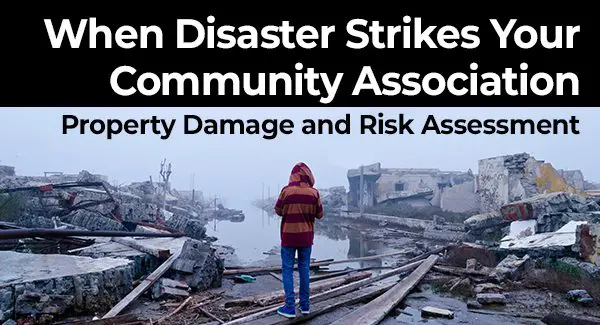- Community Associations, Board Member 101
- Wisconsin, Indiana, Illinois, Florida
A wide range of disasters affect a community association’s property, infrastructure, financial stability, and the safety of its residents. Natural disasters that can impact condominium, homeowner (HOA) and townhome community associations include fire, hurricanes, tornados, earthquakes, flooding, wildfires, landslides, and storms. Negligence and accidents can also create or contribute to a disastrous consequences.
This article will address property inspections, burst pipes, risk assessment, insurance, and more.
Property Damage: Assessing Association Responsibility
Property damage to a community association’s structures, land, and physical infrastructure, can have significant consequences. Disruptions to association operations (ex. heating, cooling, lighting, communications, security systems) can pose significant challenges.
Board members, community leaders, and property managers need to consider association responsibilities versus individual owner responsibilities when addressing property damage. The association’s attorney can assist in navigating legal issues and determining responsibilities related to property damage.
Common areas or elements refer to the spaces and elements within a community that are not owned individually but are available for all association members to use, and their maintenance is funded through the association fees collected from residents. Examples of common areas/elements can include roofs, parking lots, bike paths, stairwells, and elevators.
Limited common areas or elements are spaces or elements that are part of the association but are designated for the exclusive use or benefit of one or more, but not all, members, often due to their specific location or nature. Examples of limited common areas/elements can include balconies, waterfront docks, private gardens, and storage sheds.
Disaster Preparation: Property Inspections
It’s essential to schedule regular inspections and preventative maintenance for association common and limited common areas or elements. This includes:
- Seasonal landscaping tasks such as tree trimming, removing dead foliage, managing branches, weed control, pest management, and maintaining irrigation systems.
- Safety equipment such as fire/smoke detectors, fire extinguishers, sprinkler systems, lighting, generators, and emergency kits should be regularly checked and serviced.
- Inspections should also be carried out on elevators, stairways, walkways, and association amenities (ex. fitness center, pool) to ensure they are in good working order.
- Additionally, winterization processes should include checking pipes, mechanicals, gutters, and roofs to prepare for colder weather.
For more information, please read “Maintenance and Safety in Community Associations” here: https://www.ksnlaw.com/blog/maintenance-safety-community-associations/
Disaster Preparation: Burst Pipes
Unfortunately, burst pipes can be a common occurrence in associations impacted by cold temperatures. Pipe bursts, leaks, a failure to maintain heat, or a malfunctioning appliance can all lead to property damage.
It’s important to conduct inspections of entryways, common hallways, basements, utility rooms, and fire sprinkler lines to prepare for and prevent potential burst pipe emergencies.
For more information, please read “3 Steps to Identify Responsibility for Burst Pipes and Property Damage in an Association” here: https://www.ksnlaw.com/blog/burst-pipes/
Disaster Preparation: Risk Assessment
It is important to evaluate risks that are unique to your community, taking into consideration factors including:
- the age of the association
- the type of community (ex. downtown high-rise versus a suburban homeowners association)
- geographical location
- resident demographics
- the size of the community population
Reviewing past events is crucial to examine previous occurrences and identify potential recurrent dangers and natural disasters, such as seasonal flooding or hurricane and tornado seasons. It’s also critical to review the association’s finances to assess recovery and repair costs as well as the adequacy of reserve funds.
The association’s attorney an conduct a legal assessment encompassing a review of accessibility requirements (ex. ramps, parking spaces), examination of vendor agreements, special assessments, evaluation of the association’s legal liabilities, and a review of insurance coverage requirements as outlined by the governing documents.
For more information, please read “Understanding Condo and HOA Insurance: Coverage Types and Key Considerations for Community Associations” here: https://www.ksnlaw.com/blog/condo-hoa-insurance-coverage-community-associations/
Legal Resource
Regular property inspections, understanding the risks of burst pipes, and conducting thorough risk assessments are key to mitigating the impact of disasters in community associations. Ensuring proper insurance coverage and being well-versed in association responsibilities can help board members and property managers ease recovery efforts and keep your community resilient in the face of adversity.
Do not hesitate to contact our law firm if your association has questions regarding the board’s fiduciary duties, association policies, property maintenance responsibilities, or other legal concerns.
Please call 855-537-0500 or visit www.ksnlaw.com.
Since 1983, KSN has been a legal resource for condominium, homeowner, and townhome associations. Additionally, we represent clients in real estate transactions, collections, landlord/tenant issues, and property tax appeals. We represent thousands of clients and community associations throughout the US with offices in several states including Florida, Illinois, Indiana, and Wisconsin.
Please note the material contained in this article is for educational and informational purposes only and does not constitute legal advice. No attorney-client relationship is established by your review or receipt of the information contained in this article. You should not act on the information discussed in this article without first obtaining legal advice from an attorney duly licensed to practice law in your State. While KSN has made every effort to include up-to-date information in this article, the law can change quickly. Accordingly, please understand that information discussed in this article may not yet reflect the most recent legal developments. Material is not guaranteed to be correct, complete, or up to date. KSN reserves the right to revise or update the information and statements of law discussed in the article law at any time, without notice, and disclaims any liability for your use of information or statements of law discussed on the article, or the accessibility of the article generally. This article may be considered advertising in some jurisdictions under applicable law/s and/or ethical rules/regulations. © 2024 Kovitz Shifrin Nesbit, A Professional Corporation.


